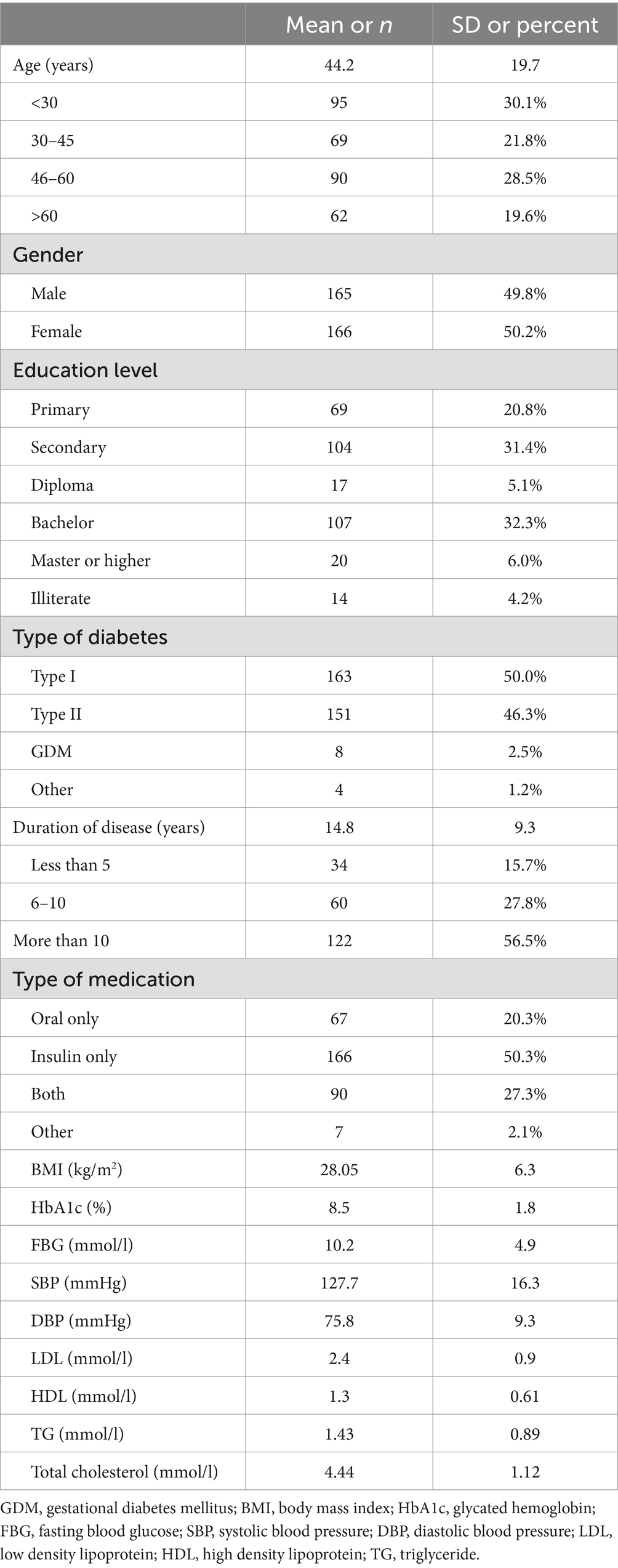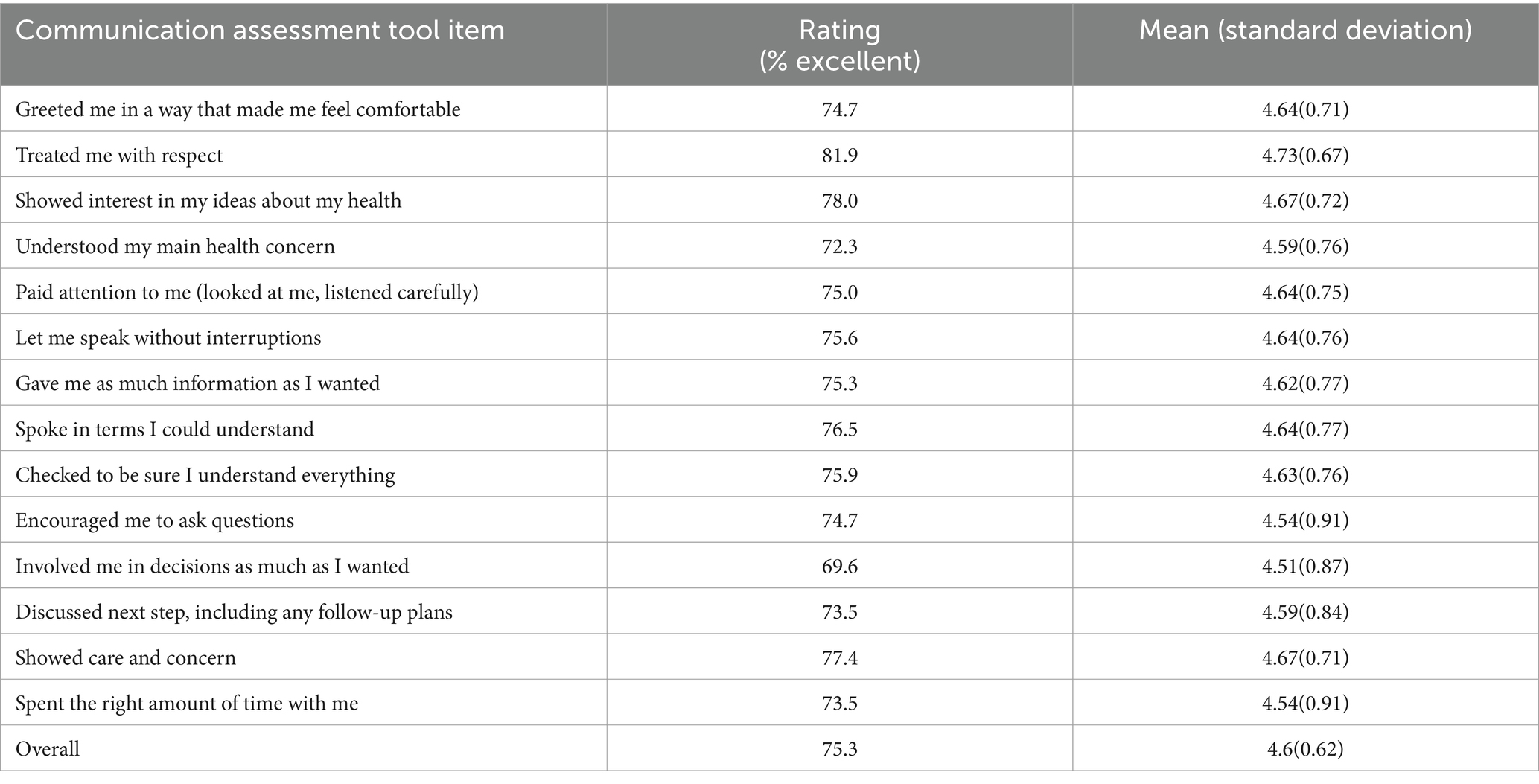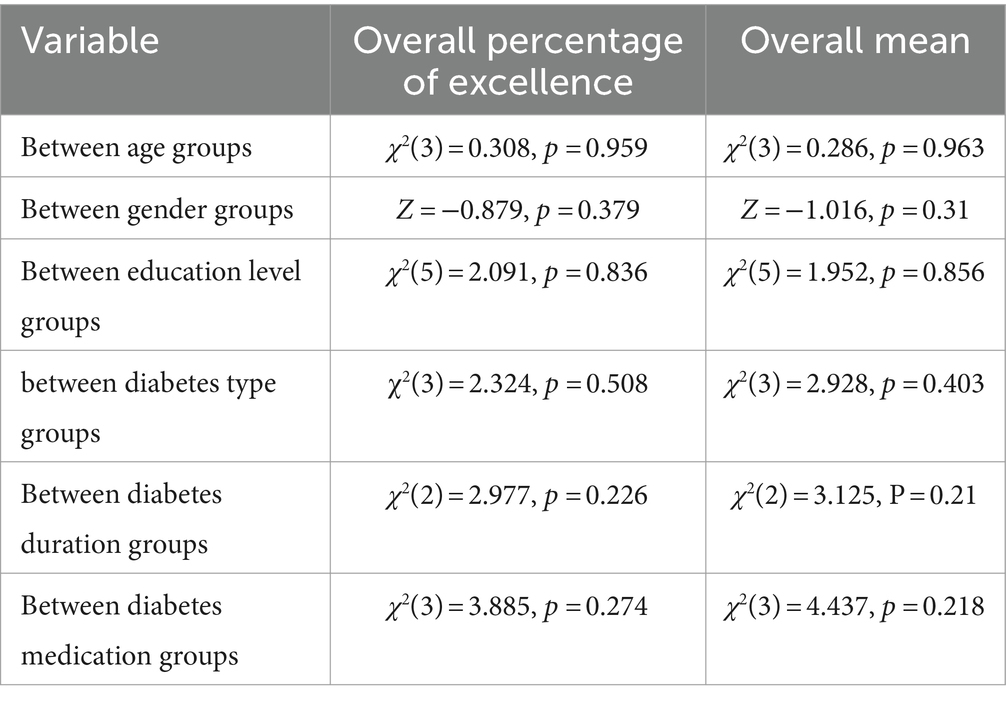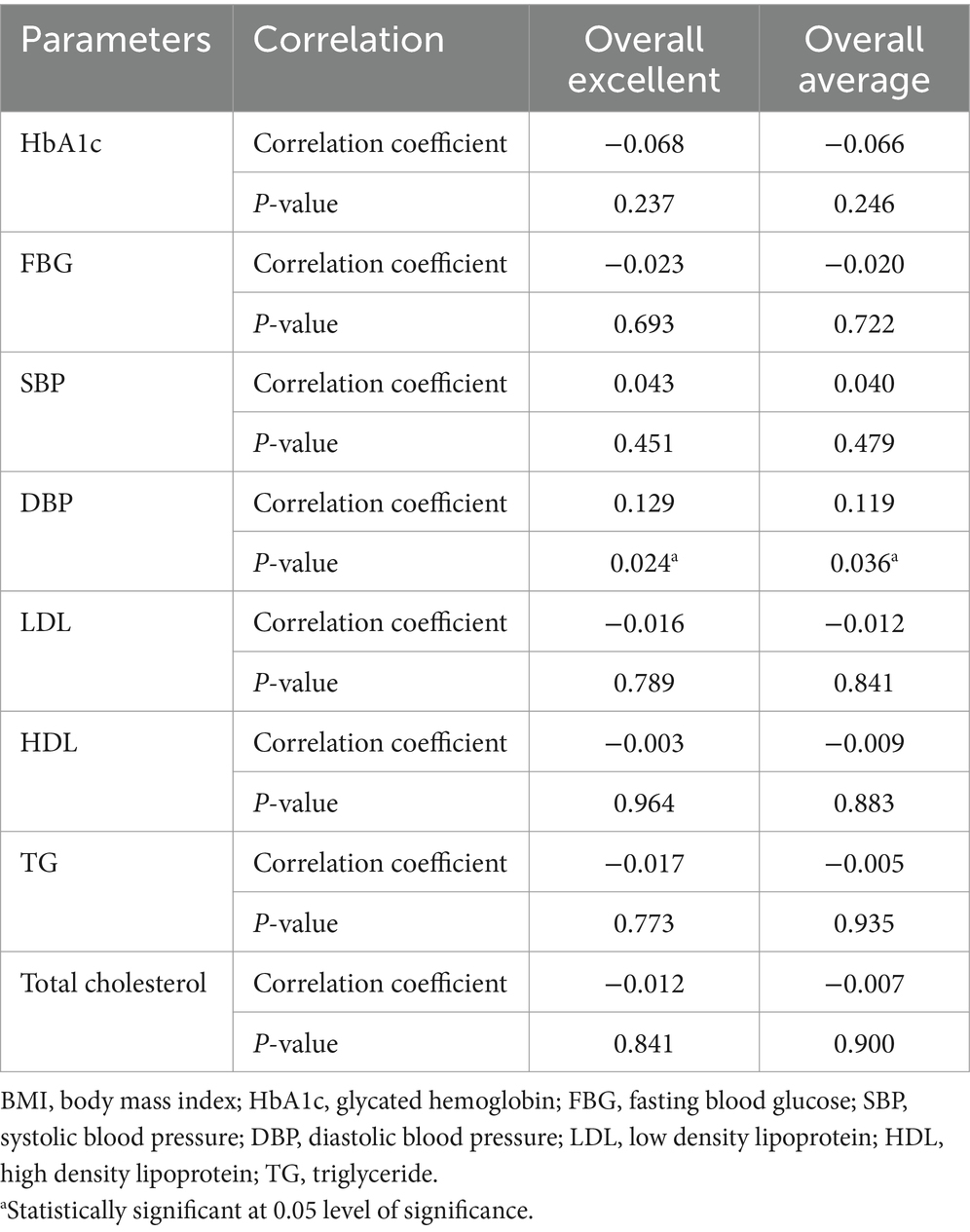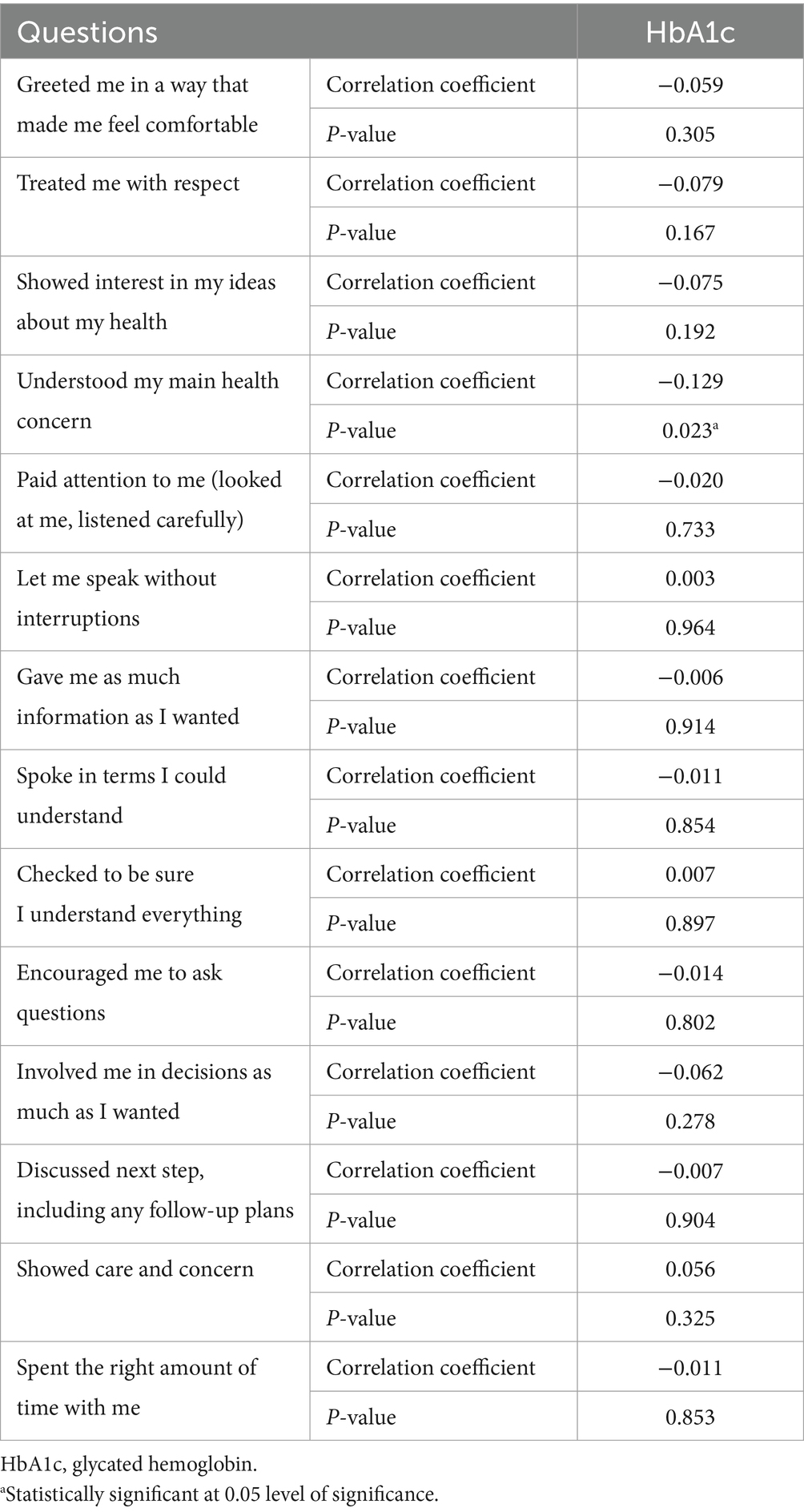- 1Department of Family and Community Medicine, Armed Forces Hospital, Jubail, Saudi Arabia
- 2University Diabetes Center, King Saud University Medical City, King Saud University, Riyadh, Saudi Arabia
- 3College of Medicine, King Saud University, Riyadh, Saudi Arabia
- 4College of Medicine, King Faisal University, Al-Ahsa, Saudi Arabia
- 5Vision Colleges, Faculty of Medicine, Riyadh, Saudi Arabia
Objectives: The purpose of the study was to evaluate the impact of physicians’ communication skills on glycemic control in type I and II diabetes patients.
Method: This cross-sectional study was conducted at the diabetic center at King Saud University Medical City, Riyadh, Saudi Arabia. The Arabic version of the communication assessment tool was used to evaluate the patient’s perception of the physicians’ communication skills.
Results: A total of 348 patients were invited to participate in the study in which 332 filled the questionnaire completely and hence participation rate was 95.4%. The average age of the patients was 44.2 (±19.7) years with an almost equal gender ratio. The percentage of excellent ratings for most of the questions was varying between 70 and 80%. The overall percentage of excellent ratings was 75.3%. Glycated hemoglobin and other metabolic features except for diastolic blood pressure did not have any significant association with the overall mean communication assessment tool score and the percentage of excellent rating.
Conclusion: Study findings provided high patient satisfaction with their physicians’ communication skills. However, diabetes and metabolic control were not affected by this satisfaction. Hence, improvement in the communication skills of the physicians is recommended.
Introduction
Diabetes mellitus (DM) is a non-communicable chronic disease, and a continuous increase in its prevalence has been reported globally. By 2024, the estimated number of patients with diabetes globally is 629 million. It contributes to severe consequences and increases the economic burden through its complications (Mishra et al., 2024). According to the International Diabetes Foundation (IDF), the prevalence of diabetes in Saudi Arabia in 2021 was 17.7%, which comprised over 4.2 million of the total population (International Diabetes Federation, 2021). Moreover, other metabolic syndrome components including hypertension, dyslipidemia and obesity were found to be a critical risk factors for diabetes complication and all-cause mortality (Metascreen Writing Committee, 2006; Hui et al., 2010). Noteworthy, the cardiovascular risk increases synergistically with several metabolic parameters concurring (Bonora et al., 2004).
DM is among those diseases in which self-care plays a significant role in the long-term management of the disease and in avoiding complications related to the disease (Lambrinou et al., 2019). The patient and family perform more than 95 percent of diabetes management, while physicians primarily give self-management recommendations (Alramadhan et al., 2023). The quality of the communication between the patient and the physician is considered an essential factor affecting the patient’s self-management behavior (Lambrinou et al., 2019). Effective communication is not just a skill but a crucial component of physicians’ patients’ management. It plays a significant role in delivering high-quality healthcare in terms of diagnosis and treatment (Lambrinou et al., 2019; Bartkeviciute et al., 2023). Good communication skills can establish a healthy physician-patient relationship, which in turn, increases compliance with the physicians’ instructions and higher satisfaction with the care provided (Bartkeviciute et al., 2023; Pierobon et al., 2023; White et al., 2015).
To assess the patient’s perception of the physicians’ communication skills, Makoul et al. (2007) developed a validated Communication Assessment Tool (CAT) (Cronbach’s alpha = 0.96). This tool has been used in various research conducted in different fields of medical sciences (Świątoniowska-Lonc et al., 2020; Palis et al., 2020; Armellino et al., 2022). However, very little use of this tool has been witnessed in evaluating physicians’ communication skills and diabetes-related outcomes. Therefore, the present study assessed the impact of physician communication skills on glycemic control in patients with DM. In addition, it assessed the impact of physician communication skills on other metabolic parameters.
Method
This cross-sectional study was conducted from November 2022 to June 2023 at diabetes clinics at a tertiary hospital in Riyadh, Saudi Arabia. It was conducted according to the relevant guidelines and regulations and the Institutional Review Board of the College of Medicine, King Saud University, Saudi Arabia reviewed and approved the protocol (E-22-7226).
Participants
The study’s targeted population was carefully selected, focusing on patients with diabetes who can communicate in Arabic and regularly visit the adult diabetes clinics at the diabetic center. We excluded those with only one clinic visit. The study required sample size was calculated using a rigorous simple random sampling technique with a 95% confidence interval, resulting in a robust sample of 351 patients.
Procedure
The communication assessment tool (CAT), which is a psychometrically sound instrument, was used to evaluate the patients’ perception of the physicians’ interpersonal and communication skills based on their most recent clinical visit (Makoul et al., 2007). The Arabic version of the CAT questionnaire, which was found to have high reliability (Cronbach’s alpha value: 0.95) (Hadhrami et al., 2021), was used in the study after obtaining permission from the authors. Hence, the questionnaire prepared for the study consisted of three parts. The first and second parts were prepared by the study authors, and the third part was the CAT questionnaire. The first part of the questionnaire consisted of the demographic variables, including age, gender, educational level, body mass index (BMI), type and duration of diabetes and medication used to control diabetes. The second part of the questionnaire consisted of laboratory tests, including fasting blood glucose, Glycated hemoglobin (HbA1c), low-density lipoprotein (LDL), high-density lipoprotein (HDL), triglyceride (TG), total cholesterol, and blood pressure. The CAT consisted of 14 questions to evaluate the communication and interpersonal skills of the physician. Each question of CAT asks the respondent to rate the statement using a five point-Likert scale (1 = poor, 2 = fair, 3 = good, 4 = very good, 5 = excellent). The average of all items is considered as the overall score. The percentage of excellent rate represents the proportion of patients reporting an excellent score for each item. The data was collected during the patients’ visit to the diabetic clinics, and the questionnaire was provided to them while they were waiting in the waiting area. The informed consent form was explained to the patient and signed before the questionnaire was provided. The questionnaire was self-administered; therefore, the data collection team provided the questionnaire to the patients after explaining the purpose of the study. Patients were asked to fill only the first and third parts of the questionnaire, while the data for the second part was obtained from the electronic medical records with the latest available blood investigations.
Statistical analyses
A statistical package for social sciences (SPSS v.23) was used to analyze the collected data. The overall CAT score was calculated by taking the average of the 14 CAT questions. In addition, an overall excellent percentage out of the 14 questions was also calculated. Data was demonstrated by mean and standard deviation (SD) or number and percentage for numerical and categorical variables, respectively. The normality of the data was tested using the Shapiro–Wilk test, and the data was found to be not normally distributed. Hence, non-parametric tests were used for inferential analysis. The Mann–Whitney U test was used to find the effect of categorical variables with two categories on the continuous variables. The Kruskal–Wallis test was used to determine the effect of categorical variables with more than 2 categories (like age and duration of disease) on the continuous variables. Spearman correlation was used to evaluate the correlation between the continuous variables. All p-values less than 0.05 were considered statistically significant.
Results
Out of the total 348 patients who filled out the questionnaire a substantial 332 were included in the analysis after the exclusion of incomplete questionnaires, with a high participation rate of 95.4%. The gender distribution was almost equal, and the average age of participants was 44.2 ± 19.7 years. Nearly half of the patients had type I DM, while the average duration of the disease was 14.8 ± 9.3 years. Almost half of the patients were on insulin-only treatment (Table 1).
Table 1 also summarizes the outcome of the laboratory parameters. The average BMI of the participants was 28.05 ± 6.3 kg/m2. The average HbA1c was 8.5 ± 1.8%, and the average fasting glucose level was 10.2 ± 4.9 mmoL/L.
The percentage of excellent ratings and average scores for each item of the CAT tool was tabulated in Table 2. The excellent rating for questions varied between 70 and 80%. The overall excellent rating of CAT questions was 75.3%, while the average overall score was 4.6 ± 0.62. In addition, the highest rating was 81.9% for the question “Treated me with respect,” while the lowest excellent rating was 69.6% for the question “Involved me in decisions as much as I wanted”. However, the average score for each question was higher than 4 and varied between 4.51 and 4.73.
The demographic variables of the study participants were analyzed using the overall percentage of excellent and overall mean score of CAT items (Table 3). There was no significant difference in the overall percentage of excellent or overall mean score between the demographic variables’ categories.
By computing correlations using the Spearman correlation test, we studied the relationship of clinical parameters with the overall excellent rate and average score (Table 4). It was found that only diastolic blood pressure (DBP) had a significant positive correlation with both overall excellent percentage and overall average (correlation coefficient = 0.129, p = 0.024; correlation coefficient = 0.119, p = 0.036 respectively); however, the coefficient of correlation provided that there was a weak relation between the two variables (Table 4).
The results showed that one item of CAT “Understood my main health concern” had a significant association with HbA1c level (p = 0.023); however, the coefficient of correlation revealed a weak but inverse relationship between the question and HbA1c level (Table 5).
Discussion
In the present study, we aimed to evaluate the patients’ satisfaction with their physician’s communication skills and its impact on their diabetes control and other metabolic parameters. On the five-point Likert scale, where 4 and 5 showed very good and excellent, respectively, the average score for each CAT item was more than 4. This showed that the patients rated their physicians’ communication skills between “very good” and “excellent.” The percentage of the excellent score was also found; 12 out of 14 items got a percentage of excellent between 70 and 80, while only one item had over 80, and one had less than 70 percent of the excellent rating. The study findings did not provide any correlation between the percentage of excellent rating and overall mean score with HbA1c level and other metabolic factors but only a significant weak positive correlation with DBP. Moreover, only the highest satisfaction of physician understanding of the patient’s health concern was associated with lower HbA1c.
Considering the high satisfaction score in our study, similar results were reported by a study from Saudi Arabia, which included physicians from various specialties in evaluating their communication skills. The findings of this study revealed that each item of the CAT tool received an average score of over 4 (Alotaibi et al., 2019). In another study by Alsaad et al. (2016) from Saudi Arabia evaluating the satisfaction of patients with family medicine residents’ communication skills reported a similar high average score, which was at least 4.5 for the CAT items. A study from the United States also found a minimum of 4.47 average score when employing the CAT tool for the communication assessment of family medicine residents (Myerholtz et al., 2010). Moreover, other studies had a similar pattern regarding the percentage rating of excellent; even some studies found more than 80% of excellent ratings for each CAT item (Qari et al., 2020; Myerholtz, 2014).
However, a study published in Poland included hypertensive patients and evaluated their satisfaction with the communication skills of their physicians. The average percentage of excellent scores was low (29–51%) (Świątoniowska-Lonc et al., 2020). Gessesse et al. (2022) also found dissatisfaction among patients with physicians’ communication skills in the Ethiopian comprehensive specialized hospitals, with an overall mean CAT score of 2.69.
The lowest percentage of excellent ratings in this study was received by question 11, which was also shown in other studies (Świątoniowska-Lonc et al., 2020; Alsaad et al., 2016; Myerholtz et al., 2010). This question was about the involvement in the decisions as much as a patient wanted. Diabetes management has many aspects that patients are recommended to follow, not only the medication consumption. They are advised for diet control, a physically active life, regular glycemic monitoring, and so on. Those are sometimes uncomfortable for the patients, and they want their leverage over the things for which they have been guided. Hence, probably due to this, the present study participants thought they had yet to be involved in making decisions as much as they wanted.
Effective communication and a healthy patient-doctor relationship play a key role in properly adhering to the treatment plan and medicine and supporting individualized diabetes care (Bartkeviciute et al., 2023; Pierobon et al., 2023). Unfavorable outcomes or delayed recovery are sometimes due to improper communication between patients and doctors (Hashim, 2017; Fawole et al., 2013). However, our study did not find a correlation between patients’ satisfaction with their physician communication skills and diabetes outcomes. This finding was similar to that of White et al. (2015), as they found no association between the overall mean CAT score and HbA1c level after adjustment of the cofounder. However, they found better communication associated with higher medication adherence and treatment satisfaction (White et al., 2015). Moreover, other published studies also did not find an association between patient satisfaction with physician communication and diabetes control (Al Shahrani and Baraja, 2014; Ahmed et al., 2016). Our results could be due to overall high satisfaction of physicians’ communication with an acceptable glycemic and metabolic control of the patients included in the study. It is also possible that other factors, such as medication adherence and self-care behaviors, play a more significant role in diabetes control than patient satisfaction alone.
As mentioned, better glycemic control was associated with higher patient satisfaction with their physician’s understanding of their health concerns. This could be expected as it reflects the patient’s trust in their physician, encouraging them to follow their management plan according to their concerns.
To our knowledge, this is the first study in Saudi Arabia that has assessed the association between communication quality using a valid communication assessment tool and diabetes outcomes. It is important to note that the results of our study were limited to a single tertiary center, which may not fully reflect the general practice of diabetes management in primary care centers. Additionally, the sample size was not large enough to generalize the study findings. Furthermore, our study was limited to evaluating the effect of communication skills on glycemic control and other metabolic parameters. It did not include other factors affecting diabetes management, such as medication adherence, self-care behaviors, self-efficacy, and treatment satisfaction. Understanding these limitations is crucial for interpreting our study findings and guiding future research in this area.
Conclusion
There was a high patient satisfaction with their physicians’ communication skills in the diabetes management field. While our study found no significant association between the communication skills of physicians and diabetes control, it does not discount the importance of effective communication in diabetes care. We recommend further research with a larger sample size of multiple centers and a broader assessment of other diabetes care components to fully evaluate this hypothesis. This ongoing research is crucial for the continuous improvement of diabetes management strategies and the enhancement of patient outcomes.
Data availability statement
The data supporting the findings of this study are available from the corresponding author upon reasonable request.
Ethics statement
The studies involving humans were approved by The Institutional Review Board of College of Medicine, King Saud University, Riyadh, Saudi Arabia. The studies were conducted in accordance with the local legislation and institutional requirements. The participants provided their written informed consent to participate in this study.
Author contributions
FNA: Conceptualization, Data curation, Investigation, Methodology, Project administration, Writing – original draft, Writing – review & editing. KHA: Conceptualization, Data curation, Formal analysis, Methodology, Supervision, Validation, Writing – original draft, Writing – review & editing. AIA: Investigation, Writing – original draft, Writing – review & editing. AKA: Investigation, Writing – original draft, Writing – review & editing. KDA: Investigation, Writing – original draft, Writing – review & editing. NNA: Investigation, Writing – original draft, Writing – review & editing. ANA: Investigation, Writing – original draft, Writing – review & editing. AAA: Conceptualization, Investigation, Methodology, Writing – original draft, Writing – review & editing.
Funding
The author(s) declare that no financial support was received for the research, authorship, and/or publication of this article.
Conflict of interest
The authors declare that the research was conducted in the absence of any commercial or financial relationships that could be construed as a potential conflict of interest.
Publisher’s note
All claims expressed in this article are solely those of the authors and do not necessarily represent those of their affiliated organizations, or those of the publisher, the editors and the reviewers. Any product that may be evaluated in this article, or claim that may be made by its manufacturer, is not guaranteed or endorsed by the publisher.
References
Ahmed, S. F., Abdel-Wahid, H. A., Mohamed, R., and Mohammad, Y. M. (2016). Patients’ satisfaction with type 2 diabetes care and its relation to their glycaemic control-primary health care setting, port said, Egypt. Suez Canal Univ. Med. J. 19, 117–126. doi: 10.21608/scumj.2016.44170
Al Shahrani, A., and Baraja, M. (2014). Patient satisfaction and it's relation to diabetic control in a primary care setting. J. Family Med. Prim. Care 3, 5–11. doi: 10.4103/2249-4863.130254
Alotaibi, F. N., Alrabee, K., and Affaneh, M. (2019). Assessing physicians’ communication skills in their different medical specialties using the communication assessment tool. Int J Sci Stud 7:101–106.
Alramadhan, F., Herring, R. P., Beeson, W. L., Nelson, A., and Shah, H. (2023). Religiosity and type 2 diabetes self-management among Muslims residing in California. Heliyon 9:e19725. doi: 10.1016/j.heliyon.2023.e19725
Alsaad, S. M., Alshammari, S. A., and Almogbel, T. A. (2016). Appraisal of the communication skills of residents in the family medicine program in Central Saudi Arabia. Saudi Med. J. 37, 804–808. doi: 10.15537/smj.2016.7.14335
Armellino, M. F., Marini, P., Piazza, D., Manguso, F., Bottino, V., Scandroglio, I., et al. (2022). Assessment of surgeon communication skills from the patient perspective: a national evaluation using the communication assessment tool. Patient Educ. Couns. 105, 769–774. doi: 10.1016/j.pec.2021.06.010
Bartkeviciute, B., Riklikiene, O., Kregzdyte, R., and Lesauskaite, V. (2023). Individualized care for older adults with diabetes and its relationship with communication, psychosocial self-efficacy, resources and support for self-management and socio-demographics. Nurs. Open 10, 2560–2571. doi: 10.1002/nop2.1515
Bonora, E., Targher, G., Formentini, G., Calcaterra, F., Lombardi, S., Marini, F., et al. (2004). The metabolic syndrome is an independent predictor of cardiovascular disease in type 2 diabetic subjects. Prospective data from the Verona diabetes complications study. Diabet. Med. 21, 52–58. doi: 10.1046/j.1464-5491.2003.01068.x
Myerholtz, L., Simons, L., Felix, S., Nguyen, T., Brennan, J., Rivera-Tovar, A., et al. (2010). Using the communication assessment tool in family medicine residency programs. Fam. Med. 42, 567–573.
Fawole, O. A., Dy, S. M., Wilson, R. F., Lau, B. D., Martinez, K. A., Apostol, C. C., et al. (2013). A systematic review of communication quality improvement interventions for patients with advanced and serious illness. J. Gen. Intern. Med. 28, 570–577. doi: 10.1007/s11606-012-2204-4
Gessesse, A. G., Mohammed Haile, J., and Woldearegay, A. G. (2022). The nexus between physician-patient communication and health outcomes: level of patient communication satisfaction and its impact on adherence in Ethiopian comprehensive specialized hospitals. Patient Prefer. Adherence 16, 2509–2519. doi: 10.2147/PPA.S381937
Hadhrami, R. S. A., Ziedan, A. A. F., Al Rawahi, M. K., Al Mahrouqi, B. F., and Azmi, I. S. (2021). Assessing family medicine residents’ communication skills in Oman using the communication assessment tool: across-sectional study. Liaquat National Journal of Primary Care 3, 58–65. doi: 10.37184/lnjpc.2707-3521.3.16
Hui, W. S., Liu, Z., and Ho, S. C. (2010). Metabolic syndrome and all-cause mortality: a meta-analysis of prospective cohort studies. Eur. J. Epidemiol. 25, 375–384. doi: 10.1007/s10654-010-9459-z
International Diabetes Federation. IDF diabetes. (2021). Available at: https://idf.org/our-network/regions-and-members/middle-east-and-north-africa/members/saudi-arabia (accessed on 21 November 2023)
Lambrinou, E., Hansen, T. B., and Beulens, J. W. (2019). Lifestyle factors, self-management and patient empowerment in diabetes care. Eur. J. Prev. Cardiol. 26, 55–63. doi: 10.1177/2047487319885455
Makoul, G., Krupat, E., and Chang, C. H. (2007). Measuring patient views of physician communication skills: development and testing of the communication assessment tool. Patient Educ. Couns. 67, 333–342. doi: 10.1016/j.pec.2007.05.005
Metascreen Writing Committee (2006). The metabolic syndrome is a risk indicator of microvascular and macrovascular complications in diabetes: results from Metascreen, a multicenter diabetes clinic–based survey. Diabetes Care 29, 2701–2707. doi: 10.2337/dc06-0942
Mishra, A. K., Pandey, M., Pannu, A., Dewangan, H. K., and Sahoo, P. K. (2024). Review on diabetes mellitus: an insight into the current scenarios, the challenges of therapy, and application of traditional drugs. Curr. Tradit. Med. 10, 107–128. doi: 10.2174/2215083810666230501212125
Myerholtz, L. (2014). Assessing family medicine residents' communication skills from the patient's perspective: evaluating the communication assessment tool. J. Grad. Med. Educ. 6, 495–500. doi: 10.4300/JGME-D-13-00347.1
Palis, H., Marchand, K., Beaumont, S., Guh, D., Harrison, S., MacDonald, S., et al. (2020). Physician communication in injectable opioid agonist treatment: collecting patient ratings with the communication assessment tool. J. Addict. Med. 14, 480–488. doi: 10.1097/ADM.0000000000000631
Pierobon, A., Zanatta, F., Granata, N., Nissanova, E., Polański, J., Tański, W., et al. (2023). Psychosocial and behavioral correlates of self-efficacy in treatment adherence in older patients with comorbid hypertension and type 2 diabetes. Health Psychol. Report 11, 188–199. doi: 10.5114/hpr/159284
Qari, A. A., Alswat, M. M., Alharbi, B. S., and Khalil, A. (2020). Patients’ perception and residents’ self-evaluation of the communication skills of obstetrics and gynecology residents. Sulaiman Al Habib Med J 2, 174–178. doi: 10.2991/dsahmj.k.200903.003
Świątoniowska-Lonc, N., Polański, J., Tański, W., and Jankowska-Polańska, B. (2020). Impact of satisfaction with physician–patient communication on self-care and adherence in patients with hypertension: cross-sectional study. BMC Health Serv. Res. 20, 1–9. doi: 10.1186/s12913-020-05912-0
Keywords: diabetes mellitus, communication, patient’s satisfaction, glycated hemoglobin, metabolic
Citation: Alotaibi FN, Aburisheh KH, Alrasheed AI, Alazmi AK, Alamri KD, Alotaibi NN, Alotaibi AN and Alhoqail AA (2024) The impact of physician communication skills on glycemic control in patients with diabetes mellitus. Front. Commun. 9:1427374. doi: 10.3389/fcomm.2024.1427374
Edited by:
Victoria Team, Monash University, AustraliaReviewed by:
Iuliana Raluca Gheorghe, Carol Davila University of Medicine and Pharmacy, RomaniaJasim Tariq, IQRA University Islamabad, Pakistan
Natalia Świątoniowska-Lonc, 4th Military Hospital of Wroclaw, Poland
Copyright © 2024 Alotaibi, Aburisheh, Alrasheed, Alazmi, Alamri, Alotaibi, Alotaibi and Alhoqail. This is an open-access article distributed under the terms of the Creative Commons Attribution License (CC BY). The use, distribution or reproduction in other forums is permitted, provided the original author(s) and the copyright owner(s) are credited and that the original publication in this journal is cited, in accordance with accepted academic practice. No use, distribution or reproduction is permitted which does not comply with these terms.
*Correspondence: Khaled Hani Aburisheh, a2FidXJpc2hlaEBrc3UuZWR1LnNh
†ORCID: Khaled Hani Aburisheh, https://orcid.org/0000-0001-9528-6993
 Faisal Nahes Alotaibi
Faisal Nahes Alotaibi Khaled Hani Aburisheh
Khaled Hani Aburisheh Abdulelah Ibrahim Alrasheed
Abdulelah Ibrahim Alrasheed Alwaleed Khalaf Alazmi
Alwaleed Khalaf Alazmi Khalid Dhaifallah Alamri
Khalid Dhaifallah Alamri Nawaf Nahes Alotaibi
Nawaf Nahes Alotaibi Anas Nahes Alotaibi
Anas Nahes Alotaibi Abdulaziz Abdulkarem Alhoqail
Abdulaziz Abdulkarem Alhoqail